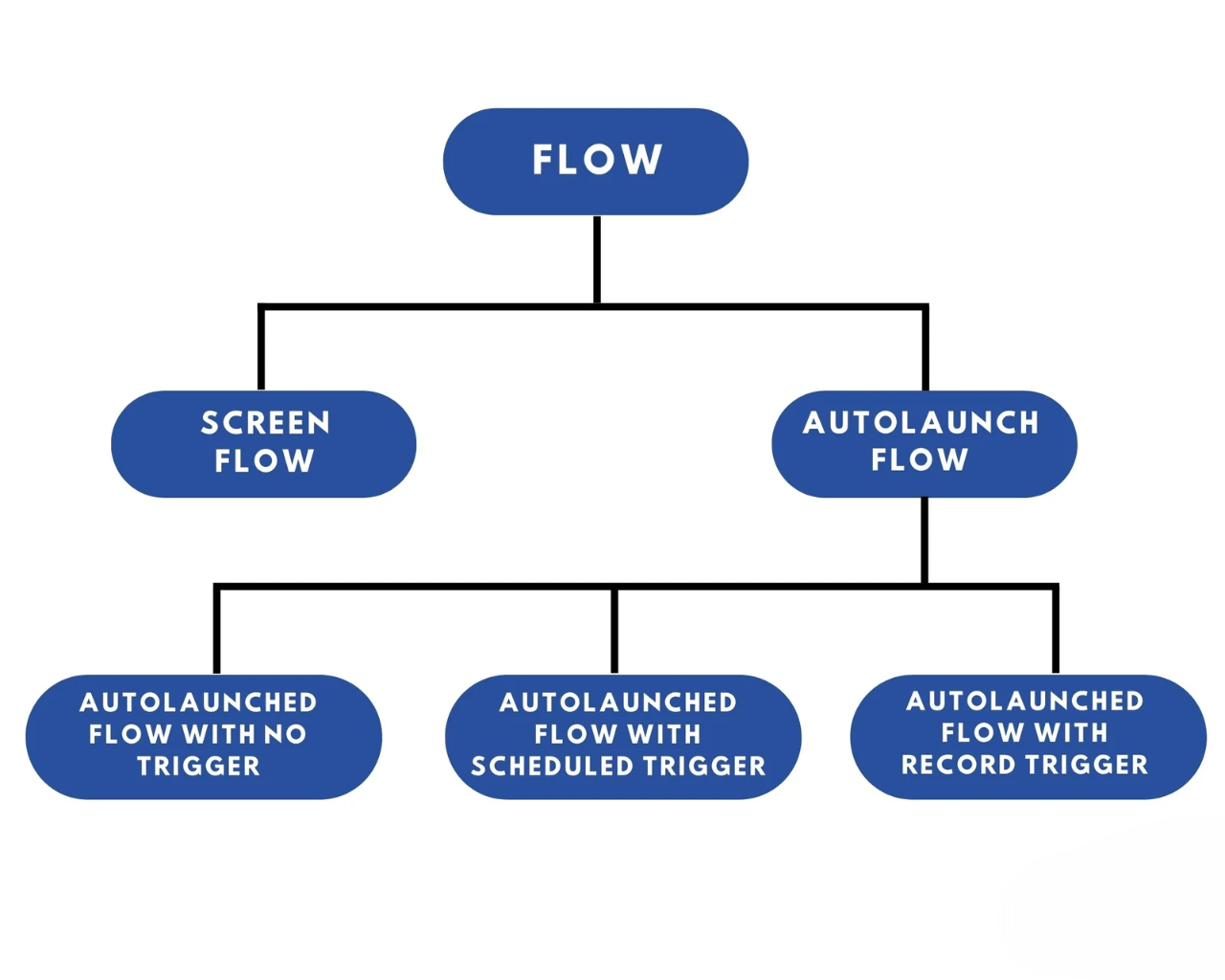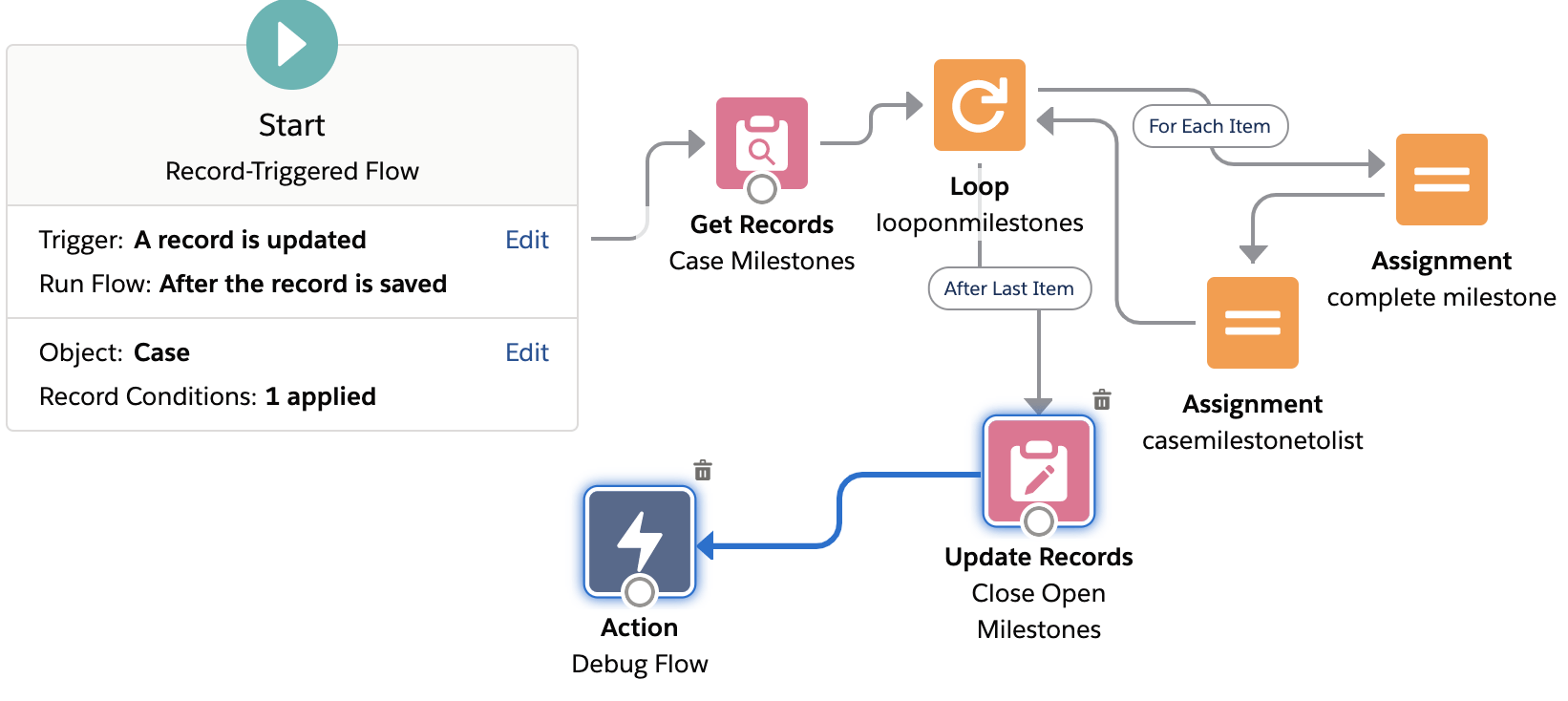
- Introduction to Salesforce Flows
- Importance of Flows in Automation
- Screen Flows Overview
- Auto-Launched Flows
- Schedule-Triggered Flows
- Record-Triggered Flows
- Platform Event-Triggered Flows
- Flow Elements and Components
- Using Flow Variables and Constants
- Flow Error Handling and Debugging
- Best Practices for Flow Creation
- Common Use Cases for Salesforce Flows
- Conclusion
Introduction to Salesforce Flows
Salesforce Flows are advanced automation tools that enable users to streamline complex business processes with minimal coding. These flows help create interactive workflows, automate repetitive tasks, and deliver seamless customer experiences. With an intuitive drag-and-drop interface, users can define data flow, set conditions, and perform actions. Flows can be triggered by various events, such as record updates, scheduled triggers, or platform events. With Salesforce Flow Builder, even non-technical users can design and manage automated processes, ensuring greater business efficiency, consistency, and accuracy. By automating routine tasks, businesses can save time, reduce errors, and boost productivity, offering a more personalized and responsive customer experience. For those looking to enhance their skills, Salesforce Training provides the resources needed to master these powerful tools.
Importance of Flows in Automation
Flows play a critical role in business process automation by streamlining operations and reducing manual effort. Key benefits of using flows include:
- Efficiency and accuracy: Automating repetitive tasks reduces human error and improves data accuracy.
- Consistency: Flows ensure that business rules and processes are consistently applied.
- Enhanced productivity: Automating tasks like record updates, email alerts, and approvals allows employees to focus on higher-value activities.
- Improved customer experience: Flows can automate personalized customer interactions, ensuring timely and relevant responses.
- Scalability: As businesses grow, flows allow for scalable and adaptable automation without extensive development.
Become a Salesforce expert by enrolling in this Salesforce Training Online Course today.
Screen Flows Overview
Screen Flows are interactive tools that guide users through a series of screens, either collecting information or providing instructions. These flows are ideal for data collection, allowing users to input details through interactive forms. They also create wizard-like experiences for multi-step processes such as onboarding or product configuration. Additionally, Screen Flows offer real-time user guidance by displaying instructions or help content. Conditional navigation directs users based on input, applying decision logic for a tailored experience. To ensure these flows function as intended, it’s important to understand What is Salesforce Testing which helps validate flow behavior and reliability. For example, a customer support agent might use a flow to log a support case with step-by-step instructions and validation checks.
Advance your Salesforce career by joining this Salesforce Training Online Course now.
Auto-Launched Flows
Auto-launched flows run automatically in the background without user interaction. They are often triggered by external events or scheduled processes. Key features include:
- No user interface: These flows do not include screens or user prompts.
- Automated execution: Triggered by record changes, external events, or schedule-based actions.
- Data manipulation: Perform bulk data operations, such as creating or updating multiple records.
- Integration with external systems: Auto-launched flows can integrate with APIs and external services. Example: Automatically creating a follow-up task when a lead status changes to “Qualified”.

Schedule-Triggered Flows
Schedule-Triggered Flows are automation tools that execute at specified times or recurring intervals, making them ideal for time-based tasks. These flows are particularly useful for mass data updates, allowing records to be automatically updated on a daily, weekly, or monthly basis. They are also effective for batch processing, enabling operations to be executed on large datasets at scheduled intervals. Additionally, Schedule-Triggered Flows can automate recurring notifications, such as sending reminders or alerts to users or customers. With efficient scheduling capabilities, users can specify start dates, frequencies, and record criteria, making it easy to automate processes. To explore more time-saving options, it’s helpful to understand Automation Tools in Salesforce and how they support scalable, consistent operations. For example, businesses can set up flows to send monthly payment reminders to customers whose subscription renewals are approaching, ensuring timely communication and reducing the risk of missed payments.
Record-Triggered Flows
Record-Triggered Flows run automatically when a record is created, updated, or deleted. These flows are commonly used for:
- Automating record changes: Update related records or fields when a specific condition is met.
- Sending notifications: Trigger email or Slack notifications upon record modifications.
- Data validation: Enforce business rules by validating and correcting data.
- Real-time actions: Execute actions immediately after record changes. Example: Automatically creating a follow-up task when an opportunity’s stage is changed to “Negotiation.”

Platform Event-Triggered Flows
Platform Event-Triggered Flows are designed to run in response to platform events published by external systems or Salesforce processes. These flows are ideal for real-time data processing, where actions can be triggered automatically based on incoming event messages. They are particularly useful in integration workflows, helping to synchronize data between Salesforce and third-party applications seamlessly. Additionally, these flows allow for asynchronous processing, meaning events can be handled independently of user actions, ensuring that the system remains responsive even when processing multiple events. Event subscriptions enable flows to respond to custom platform events with specific conditions, making them highly customizable. For those looking to master these capabilities, Salesforce Training can provide in-depth knowledge and practical skills. For example, when a payment confirmation event is received, the flow can automatically update the customer’s payment status, providing an efficient and accurate way to manage key business processes. This automation reduces manual intervention, improves accuracy, and ensures timely responses to important events.
Are you getting ready for your Salesforce interview? Check out our blog on Salesforce Interview Questions and Answers!
Flow Elements and Components
Salesforce Flows use elements and components to define the flow logic and perform actions. Key elements include:
- Assignment: Set or update variable values within the flow.
- Decision: Add branching logic by evaluating conditions and directing the flow accordingly.
- Loops: Iterate over collections of records to perform batch operations.
- Get Records: Retrieve records from Salesforce objects based on criteria.
- Create, Update, and Delete Records: Perform data manipulation operations.
- Screen Elements: Display fields, inputs, and instructions for screen flows.
- Subflows: Reusable flows that can be called from another flow, promoting modularity and efficiency. Example: Using a Decision element to route high-priority cases to a specialized support queue.
Using Flow Variables and Constants
Variables and constants in Salesforce Flows store and reference data dynamically during flow execution. Their usage includes:
- Flow variables: Store dynamic values that change during the flow execution.
- Example: Storing the current user’s ID to reference later.
- Constants: Store fixed values used throughout the flow.
- Example: A constant that holds the company’s support email address.
- Text, number, and date variables: Handle different data types for flexibility.
- Global variables: Predefined variables that store common data, such as $Record, $User, or $Flow.
- Collections: Store multiple records or values for batch processing. Example: Using a collection variable to iterate through multiple contact records.
Flow Error Handling and Debugging
Effective error handling and debugging are crucial for maintaining the reliability and smooth operation of Salesforce Flows. Key practices for managing errors include using fault paths to handle errors gracefully and prevent flow failures, ensuring that processes don’t break unexpectedly. In screen flows, displaying user-friendly error messages helps users understand the issue and take appropriate action. The built-in flow debugger allows for step-by-step testing to identify and fix issues efficiently. Monitoring system logs is also essential, as reviewing execution logs helps diagnose and resolve problems quickly. Additionally, configuring error notifications, such as email alerts or logging errors for administrators to review, ensures that issues are addressed promptly. As automation continues to evolve, it’s worth considering What Does The Future Hold For Salesforce For Salesforce to stay aligned with upcoming innovations and best practices. For example, adding a fault path to display a custom error message when an external API call fails helps provide a clear and helpful response, improving the overall user experience and flow reliability.
Best Practices for Flow Creation
To ensure efficiency and maintainability, follow these best practices when creating Salesforce Flows:
- Use subflows: Modularize reusable components into subflows for cleaner architecture.
- Optimize decision logic: Simplify complex logic with efficient conditions and variables.
- Minimize DML operations: Batch DML operations (create, update, delete) to avoid governor limits.
- Use naming conventions: Adopt consistent naming conventions for flows, variables, and elements.
- Test thoroughly: Test flows in a sandbox environment before deployment.
- Document flow logic: Add descriptions and comments for better maintainability.
- Error handling: Implement fault paths to manage errors gracefully. Example: Using subflows for common tasks, such as sending email notifications, to avoid duplication.
Common Use Cases for Salesforce Flows
Salesforce Flows offer solutions for a variety of business processes, including:
- Lead assignment: Automatically assign leads to sales reps based on territory or industry.
- Opportunity follow-up: Trigger email reminders for pending opportunities.
- Case escalation: Automatically escalate high-priority support cases.
- Customer onboarding: Create interactive screen flows to guide new customers through onboarding steps.
- Data validation: Ensure records meet specified conditions before saving.
- Mass updates: Use auto-launched flows to update multiple records based on specific criteria. Example: Record-triggered flow to send renewal reminders 30 days before a contract’s expiration date.
Conclusion
Salesforce Flows are a powerful tool for automating business processes, boosting efficiency, and enhancing customer experiences. With features like screen flows, record-triggered flows, and platform event-triggered flows, Salesforce offers flexibility to address various automation needs. By adhering to best practices, incorporating error handling techniques, and utilizing reusable subflows, organizations can create scalable, efficient, and reliable automation solutions. To gain hands-on expertise, many professionals turn to Salesforce Training to better understand flow design and best practices. These capabilities streamline workflows, reduce manual tasks, and drive productivity, ultimately contributing to greater business success and improved operational outcomes.




